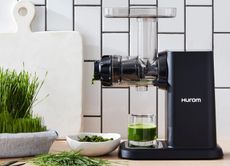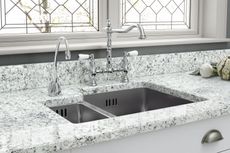How to clean a Keurig coffee maker – for consistently tasty brews
Discover how to clean a Keurig coffee maker so it works perfectly and looks good, too
- (opens in new tab)
- (opens in new tab)
- (opens in new tab)
- Sign up to our newsletter Newsletter


It’s a quick and easy way to make favorite brews, but it’s important to know how to clean a Keurig coffee maker to keep every drink tasty, and the machine looking its best.
While you might think you know how to clean a coffee maker, the Keurig requires little – but specific – attention. Add your Keurig into the routine for cleaning a kitchen so the task doesn’t get missed – both the interior and the exterior of the coffee maker need a little care. Limescale can build up inside the machine and compromise the taste and temperature of the coffee, so periodic descaling is essential, and other parts of the machine need regular attention as well.
Use our guide to cleaning a Keurig coffee maker to keep yours working just as it should for delicious drinks every time.
How to clean a Keurig coffee maker
Most Keurig machines are used for single-serve K-Cup pods, which are quick and easy to use. ‘Once you own a Keurig life becomes very simple,’ says Lucy Searle, global editor in chief of Homes & Gardens.
‘There’s no fuss or mess and it’s really quick and easy to use. To keep your coffee tasting its best, however, it’s important to clean your Keurig coffee maker regularly.’
And, of course, if you've invested in the best coffee maker, you'll want to keep it in good-as-new condition. This is how to clean a Keurig coffee maker.
1. Descale a Keurig coffee maker
Owning a Keurig allows you to be your own barista from the comfort of your kitchen. Not only does it make the perfect coffee with everything from espresso to latte, but it can also make hot chocolate and tea, too. However, the coffee maker can build up mineral deposits inside which can affect the flavor of the drinks and their temperature, so descaling from time to time is essential.
All coffee machines are different, so it is important to refer to the manufacturer’s instructions before descaling your coffee machine, advises Lynsey Crombie, Queen of Clean (opens in new tab). ‘Some offer a cleaning solution specific to the brand,’ she says. ‘You can also purchase cleaning chemicals, which clean to an industrial standard. The most popular one is by a brand named Pulycaff.’
Aim to descale a Keurig every three to six months – or when the descale light comes on if your model has one. If the machine is noisy, the coffee isn’t as hot as it should be, or the taste is impaired, it’s also time to descale.
You can descale a Keurig using pantry ingredients. Start by getting all the descaling items together – white vinegar, water, and a cup to catch the drained solution.
First, turn off the Keurig coffee maker then empty its reservoir and remove any pods. Make a mix of equal parts water and white vinegar and run it through the machine just like you’d run a normal coffee process. Pour it into the reservoir, turn it on, press the cycle button and let the solution drain into a cup.
You might need to repeat this a few times, depending on how scaly the coffee maker is. Keep following this routine until the water runs clear. Next, flush through with clean water a few times to remove any taste of vinegar.
2. Clean the exterior of a Keurig coffee maker
While the descaling process will clean a Keurig coffee maker on the inside, you should also clean any removable parts and leave to dry.
You can take the water tank and lid, coffee pod holder and drip tray apart and wash them using dish soap and warm water.
Wipe the exterior of the coffee maker with a clean sponge or paper towels and make sure you wipe the needles that puncture the coffee pods. Leave them all to dry naturally.
How often should you clean your Keurig?
Keurig recommends descaling its coffee makers every three to six months. Any mineral buildup can otherwise affect the machine’s smooth functioning.
You should also try to clean all the parts once a month for optimum hygiene and working efficiency.
Alternative ways to descale a Keurig coffee maker
Keurig offers its own Descaling Solution (opens in new tab), which we like using. It’s compatible with all Keurig K-Cup, Keurig 2.0, Rivo and Vue brewing systems.
If you don’t want to use vinegar or Keurig’s Descaling Solution, there are some other methods you can use. Surprisingly, denture tablets do the same job. Pop half a tablet in the K-Cup holder then run the coffee machine for three cycles and finish with a cycle or two of clean water until it runs clear.
Another idea is to use citric acid. Take a tablespoon of citric acid crystals to one gallon of water and run the Keurig a few times followed by clean water. Keep repeating until the water runs clear without any mineral or limescale deposits coming through.
What is the best way to clean a Keurig?
To clean a Keurig coffee maker on the inside, every three to six months, follow the descaling process and fill the reservoir with equal parts white vinegar and water or use Keurig’s Descaling Solution, following the instructions.
Start the brew cycle without a K-cup and let the machine run as usual, using a mug to catch the liquid. Keep repeating this process until the add water indicator is illuminated.
How do you descale a Keurig coffee maker with vinegar?
To descale a Keurig coffee maker with vinegar, run a mix of equal parts water and white vinegar through the machine. Pour the solution into the reservoir, turn on the machine, press the cycle button, and allow the solution to drain into a cup.

Hayley is an interiors journalist, content provider and copywriter with 26 years experience who has contributed to a wide range of consumer magazines, trade titles, newspapers, blogs and online content. Specialising in kitchens and bathrooms, she has twice won the CEDIA Award for Best Technology feature. Hayley writes for H&G about kitchens, bathrooms, cleaning, DIY and organizing.
-
-
 Nectar vs Tempur-Pedic: which mattress brand is best?
Nectar vs Tempur-Pedic: which mattress brand is best?Nectar vs Tempur-Pedic: could the iconic brand be brought to an end by a box mattress?
By Alex David • Published
-
 Candle warmers are the coziest home decor trend we've seen – here's why you need one
Candle warmers are the coziest home decor trend we've seen – here's why you need oneWe look at the benefits of candle warmers, and why you should have one in your home
By Chiana Dickson • Published
-
 How to clean a blender – keep it hygienic and make it last
How to clean a blender – keep it hygienic and make it lastIt’s a hard-working kitchen appliance, so find out how to clean a blender with our guide
By Linda Clayton • Published
-
 How to clean a stand mixer – 5 simple steps to steak-free shine
How to clean a stand mixer – 5 simple steps to steak-free shineWondering how to clean a stand mixer? We've condensed the process into 5 simple steps. Here is everything you need to know...
By Millie Fender • Published
-
 How to clean a juicer – 5 tried-and-tested tips to make juicing clean and easy
How to clean a juicer – 5 tried-and-tested tips to make juicing clean and easyIncluding advice for centrifugal and cold press juicers, here is how to clean a juicer
By Millie Fender • Published
-
 How to clean a coffee maker – and why you shouldn't use vinegar
How to clean a coffee maker – and why you shouldn't use vinegarThis is when and how to clean a coffee maker for the best-tasting brews, and why vinegar can damage your machine
By Ruth Doherty • Published
-
 What not to clean with vinegar – 10 items it can harm
What not to clean with vinegar – 10 items it can harmThese are the items that can be damaged by it, so find out what not to clean with vinegar
By Sarah Warwick • Last updated
-
 Using white vinegar in laundry – to deodorize and brighten clothes quickly
Using white vinegar in laundry – to deodorize and brighten clothes quicklyThinking of using white vinegar in laundry? This simple ingredient will leave you with soft, odorless clothes, instantly
By Megan Slack • Last updated
-
 How to clean a stainless steel sink – 5 steps to a streak-free shine
How to clean a stainless steel sink – 5 steps to a streak-free shineDiscover how to clean a stainless steel sink so it sparkles like it’s brand new
By Sarah Warwick • Published
-
 Cleaning a kitchen – 10 expert-led steps to a spotless space
Cleaning a kitchen – 10 expert-led steps to a spotless spaceWant to know how to deep clean a kitchen with ease? These tips are all you need
By Thea Babington-Stitt • Published









